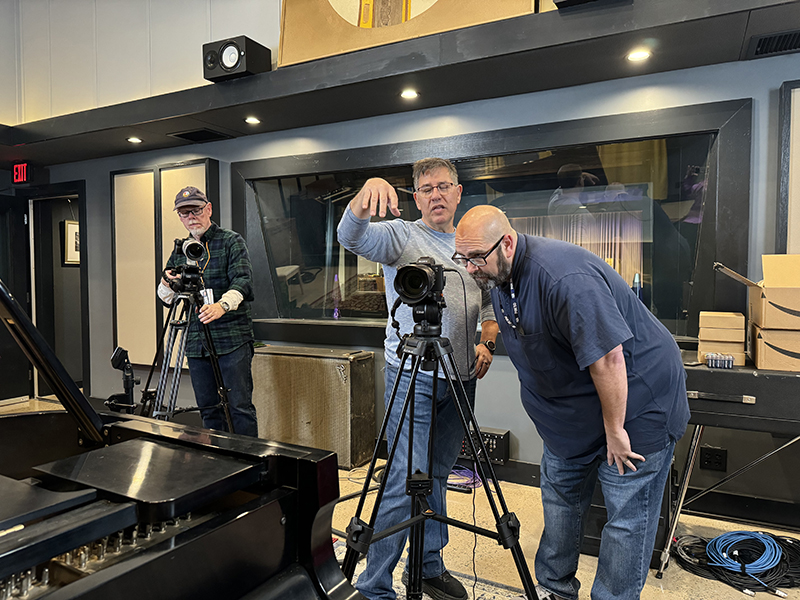WRAL-TV’s news helicopter – SKY 5 – was the first helicopter in North Carolina devoted to fulltime television newsgathering. The aircraft went into service on July 31, 1979 and within a very short time it not only covered the news– it became an active participant in many stories. SKY 5 took part in dramatic search and rescues, covered devastating storms and hurricanes, and assisted law enforcement when requested.
WRAL-TV General Manager John Greene stated in a 1981 article in Tar Heel Aviation magazine, “SKY 5 is no gimmick. What it IS, is another demonstration of our commitment to news. We have set our goal. We want to provide the best coverage, not just in the Triangle, but in the state. SKY 5 is one way of doing that.”
WRAL-TV serves a diverse 22-county region of North Carolina. The quickest way to cover breaking news is from the air, but with its ability to hover or orbit over a scene–SKY 5 provided an unobstructed, often-exciting visual perspective.
In selecting WRAL’s first helicopter, John Greene said “We wanted safety and performance.” So after consulting with helicopter pilots and operators, the decision was made to purchase the Hughes 500 D model helicopter. The Hughes’ five-bladed main rotor system provided a very stable platform for a photographer to shoot steady video, plus the 500 D model was fast and maneuverable. In fact, the Hughes 500 helicopter was often referred to as “the Ferrari of the skies.”
To facilitate use of the new aircraft, WRAL-TV submitted a request for a helistop – a pad without fueling or maintenance facilities – to be located on top of one of its buildings on Western Boulevard. That request was approved by the Raleigh Board of Adjustment. The helistop allowed the pilot to fly SKY 5 from its hangar at the Raleigh/Durham airport to the station so news crews could climb aboard and respond quickly to breaking news.
The first SKY 5 was turbine powered and routinely cruised at 165 MPH. The helicopter could comfortably carry four people, including the pilot. However it typically carried a photographer sitting up front with the pilot and a reporter sitting in the back seat.
The color and graphic scheme of the first SKY 5 was unique. The “bumblebee stripes” scheme was one of six available from Hughes Helicopters. The dominant blue color represented the air force of the country the helicopter was originally destined for – Saudi Arabia. However the Saudis reduced their original order, so Capitol Broadcasting Company stepped in to buy the aircraft that would soon become SKY 5.
WRAL Director of Promotion Steve Grissom created a marketing campaign that generated excitement with TV 5 viewers. Billboards throughout eastern North Carolina said, “The Sky is not the limit!” and “Look Up for SKY 5!” When SKY 5 went into service in 1979, WRAL viewers couldn’t get enough, and soon the state’s first news helicopter was as well-known and popular as WRAL’s on-air personalities.
The first three SKY 5 pilots were Army aviation veterans. Randy Watkins was the first pilot to fly SKY 5 full time. Randy was a Warrant Officer in the Army and served 12 months in Vietnam, after which he was assigned to Fort Bragg. Watkins left the service in 1976 and flew in the North Carolina National Guard. In 1978 he moved into commercial aviation and ten months later was offered the job to fly SKY 5.
Watkins flew news crews to locations around the state, providing aerials from scenes ranging from train wrecks to storm damage. He also aided rescue teams looking for lost children. Randy left WRAL at the end of 1981 and continued his flying career in commercial aviation.
Following Watkins’ departure, WRAL hired veteran pilot Mike Allen in January 1982. As a pilot, Mike brought a face, voice and personality to SKY 5.
Allen served as a commissioned officer in the US Army for six years. He completed flight training for the UH-1 “Huey” helicopter and later flew the large Chinook helicopters. Captain Allen served in Vietnam from 1968-1969 where he earned the Bronze Star and 21 air medals.
After Vietnam, Allen entered civilian aviation and flew helicopters for law enforcement/search and rescue operations in California. He also flew forest fire fighting missions throughout the western states as well as geological expeditions to remote regions in Alaska.
Mike arrived at WRAL-TV in January 1982 with over 11,000 flight hours of experience under his belt. He brought a new dimension to SKY 5 by adding the role of reporter to the job of pilot. During WRAL’s weather segment, Bob DeBardelaben would often talk to Mike while SKY 5 provided a live “weather window” for viewers to see cloud formations or damage from storms.
Mike Allen left WRAL in early 1984 and continued his flying career before eventually entering the ministry as an ordained Presbyterian minister.
Frank Beall became the next SKY 5 pilot, joining the WRAL team in late 1984. Beall flew the original WRAL aircraft briefly, but soon took command of the next helicopter bearing the SKY 5 designation. The second SKY 5 went into service on December 7, 1984. It was another Hughes 500 D model, but featured a more powerful turbine engine that made it faster and upgraded avionics to help the pilot navigate to remote locations more easily.
Like the previous two SKY 5 pilots, Beall learned to fly in the military. U.S. Army Captain Frank Beall flew in Vietnam as a scout pilot in a light observation helicopter, the Army version of SKY 5. Beall’s helicopter was shot down and he was wounded on June 5, 1972. He was picked up by another helicopter which was shot down as well. Beall survived both crashes and earned the Purple Heart. After discharge he flew in civilian aviation until he was hired by WRAL.
As pilot, Frank was not a regular on-air personality, but on occasion he would offer witty observations from SKY 5 during the station’s weathercasts. He also continued to build a strong relationship with law enforcement agencies and aided officials in search and rescue efforts when necessary.
Beall left WRAL in 1987 and continued his civilian aviation career in Florida before eventually retiring. He died in 2011 and is buried at Arlington National Cemetery.
SKY 5’s next pilot arrived in 1988 with a wealth of helicopter flying experience.
Steve Wiley’s aviation career started in 1980 and for the next three years he flew aircraft all over Northern Ontario, the northwest territories of Canada and Oregon. In 1983 he moved to Pittsburgh as a flight instructor. While in Pittsburgh, Steve started flying news helicopters. His first station was WPXI-TV followed by WPVI-TV in Philadelphia. Steve then moved to WABC-TV in New York City before accepting the SKY 5 assignment and moving to WRAL in 1988.
Steve flew the Hughes 500 D version of SKY 5 for ten years, but in 1998 helped develop and purchase a bigger, better aircraft that was destined to usher in the modern era of aerial newsgathering at WRAL-TV.
WRAL-TV’s latest SKY 5 – a Bell Helicopters 407 Model – was purchased in August 1998. It arrived in Raleigh two months later and was then flown to a custom facility in Tennessee for design and installation of the latest high tech equipment.
In Tennessee, the Bell 407 was equipped with $600,000 worth of video equipment, including two cameras in the cabin, one on the tail, and a powerful gyroscope-controlled HD camera under the nose. Each camera is controllable from the rear of the aircraft by a WRAL videographer.
Not only was SKY 5 a brand new aircraft – it took on a new FAA designation at the same time. The new FAA tail number, “N553HD,” reflects the helicopter’s television heritage. The first “5” represents WRAL’s longtime analog channel; the number “53” represents WRAL’s first digital channel; while “HD” honors WRAL’s pioneering status in the development of high definition television.
The custom technical work took half a year to complete, and on June 1, 1999, the new SKY 5 went into service to launch the latest chapter of newsgathering in the skies of North Carolina. SKY 5 and pilot Steve Wiley continue to provide aerial news coverage to WRAL-TV viewers—a tradition that started more than 35 years ago.





